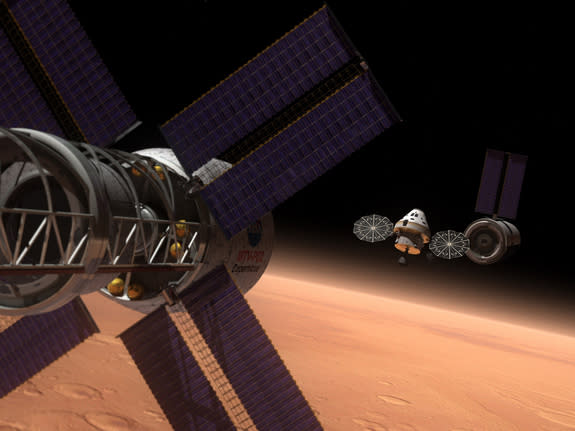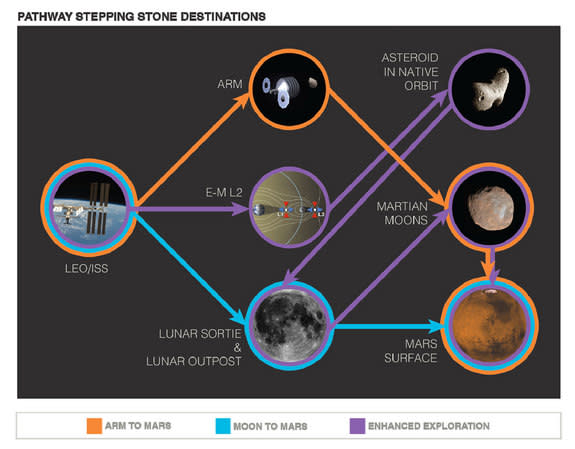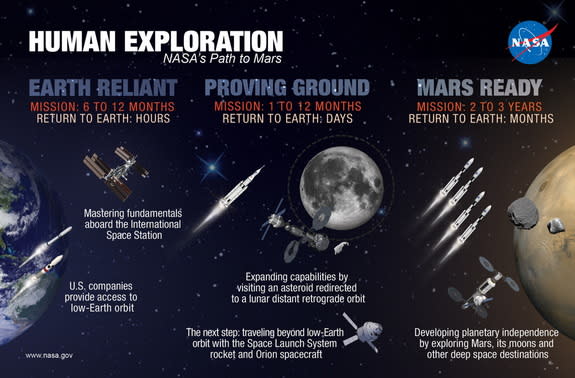To Send Astronauts to Mars, NASA Needs New Strategy: Report
Landing astronauts on Mars should continue to be the ultimate goal for the United States' human spaceflight program, but a change in NASA's approach and a significant boost in funding are needed to make it happen, a new report finds.
A manned mission to Mars, specifically the Martian surface, is the most distant and difficult goal for astronauts that is still feasibly attainable within the foreseeable future, according to the nearly 300-page report by the National Research Council's Committee on Human Spaceflight. The report, entitled "Pathways to Exploration: Rationales and Approaches for a U.S. Program of Human Space Exploration," was released Wednesday (June 4).
The NRC committee found that in order to reach the Red Planet, NASA's current budget-driven, capability-based exploration strategy needs to be replaced by one that is guided forward by interim destinations, including possibly the moon. NASA is currently pursuing a path to Mars that omits a return to the lunar surface in favor of sending astronauts to a redirected asteroid by 2025, followed by sending a crew to orbit Mars by the mid-2030s. [The Boldest Mars Missions of All Time]
"If a change of mind on the part of enough people — if enough sufficient leadership cannot be summoned — then we don't find Mars to be a realistic goal at all," said former Indiana Gov. Mitch Daniels, the committee's co-chairman and current president of Purdue University, in a public briefing Wednesday in Washington, D.C. "We're suggesting that the national leadership organize itself around a new approach that will make Mars, and other great achievements of exploration en route there, realistic in a way they are not presently."
NASA's Mars-bound path
In a response to the report, NASA officials agreed with the committee's identification of Mars as the ultimate goal.
"NASA has made significant progress on many key elements that will be needed to reach Mars, and we continue on this path in collaboration with industry and other nations," space agency officials said in a statement. "We intend to thoroughly review the report and all of its recommendations."
Unlike previous reports that have sought to evaluate the path forward for U.S. space exploration and have ultimately recommended Mars as the goal, the research council's "Pathways to Exploration" focuses on making the goal obtainable, said Jonathan Lunine, the committee's other chairman and the director of the Center for Radiophysics and Space Research at Cornell University.
"Yes, the idea of Mars as the horizon goal is not new," Lunine said. "What's different about this report is that we're recommending an approach that will provide a robust way of getting to Mars in an endeavor that will take decades and hundreds of billions of dollars and, quite probably, human lives. It is the staying power of the pathways approach and its ability, essentially, to make the program resilient against changes that we think is a novel aspect of our report."
The report's broad perspective, taking into account such considerations as public opinion and the rationales for continued human spaceflight, also distinguishes this report from previous ones, Lunine said.
The committee found that no single rationale, either practical or aspirational, justified the further pursuit of human spaceflight. But if considered with the practical benefits, the aspirational rationales — including the survival of the human species through off-Earth settlement and the shared human desire to explore — could argue for it to continue, as long as the program adopts a stable and sustainable approach.
"So, in essence here, the whole is greater than the sum of the parts, and it is the aggregate of the aspirational and the pragmatic that, in the committee's opinion, motivate human spaceflight and human space exploration," Lunine said at the hearing.
Pathways to Mars
The report offers three different pathways to illustrate the trade-offs among affordability, schedule, developmental risk and the frequency of missions for different sequences of intermediate destinations. All of the pathways culminate in landing on the surface of Mars and have anywhere between three and six steps that include some combination of human missions to the asteroids, the moon and Mars' moons Phobos and Deimos.
While the committee was not asked to recommend a particular pathway to pursue, it found that a return to extended operations on the surface of the moon would make significant contributions to a strategy ultimately aimed at landing people on Mars, and that it would also likely provide a broad array of opportunities for international and commercial cooperation.
The report also identified 10 high-priority capabilities that should be addressed by current research and development activities, with a particular emphasis on Mars entry, descent, and landing, radiation safety, and in-space propulsion and power. These three capabilities, the committee said, will be the most difficult to develop in terms of costs, schedule, technical challenges, and gaps between current and needed abilities.
"I hope [our report] carries the national conversation forward in the direction of realism — realism about public opinion, realism about risk, realism about cost and the incredibly daunting technical challenges of the horizon goal [of going to Mars] that we believe the world embraces," Daniels said.
"We're optimistic," he concluded. "We believe the public will support it; we believe the rationales justify it; we believe the achievement would be monumental if it occurred. But we believe there is one, and possibly only one, way to get there, and we've offered it up in this report."
To read the full "Pathways to Exploration" report, see the National Research Council's website: www.nas.edu/humanspaceflight.
Robert Z. Pearlman is a Space.com contributing writer and the editor of collectSPACE.com, a Space.com partner site and the leading space history-focused news publication. Follow us @Spacedotcom, Facebook and Google+. Original article on Space.com.
Copyright 2014 SPACE.com, a TechMediaNetwork company. All rights reserved. This material may not be published, broadcast, rewritten or redistributed.



